Best Retail Apps to Learn from for Improving the In-Store Experience
In this article, we’ll look at success stories of famous brands and discuss why your business needs a mobile app.
10 retail mobile apps to learn from
Building and running a branded business application might not be enough. While the opportunities seem endless, many entrepreneurs are out of luck. The most successful of them have many similarities.
1. Nike

Nike is a renowned sportswear brand that has expanded its reach to offer its customers a more complete health and fitness experience. First, Nike created a membership program in 2006 to grow its loyal customer base. Nike then launched its fitness app, which is available to everyone for free. The app offers guided workouts and helps customers shop for Nike products.
Nike recently launched the Nike app. The platform provides members with personalized access to the brand’s products in Southeast Asia and India. The Nike app provides many benefits, such as exclusive access to the latest product releases.
Based on a company report, Nike’s revenue jumped 96% compared to the blockade-affected quarter a year ago, reaching $12.3 billion, or 21% higher compared to the fourth quarter of 2019. This shows that the company has grown significantly. What’s more, thanks to Nike’s direct and digital metrics, direct sales rose 73% to $4.5 billion, accounting for a third of total revenue.
2. Ikea

Ikea Place is an app where shoppers can take a photo of a spot in their home and virtually place Ikea furniture to see how it fits in the room. This generates interest and prompts buyers to go directly to specific products when they visit an Ikea store. After selecting a piece of furniture by scanning a page of a printed catalog, users are asked to place the catalog on the floor, where it serves as an anchor for a 3D representation of the furniture.
The Ikea Place app has improved and simplified the decision-making and shopping process for customers. It has been downloaded almost 8.5 million times according to company reports.
3. McDonald’s

McDonald’s has used not only its mobile app but Instagram, one of the most popular photo and video sharing apps in the world, to interact with customers in new ways and promote underrated products. Back in March 2013, the company held a promotion in which customers were invited to take pictures of their favorite food using a mobile application.
Moreover, McDonald’s launched an app in which customers can not only access the menu but get exclusive vouchers to encourage them to order.
McDonald’s also ran its sixth iAd campaign, which not only advertised the company’s products but leveraged the power of mobile devices to provide an interactive experience. The company’s Instagram presence has proven to be a real success, as it has brought renewed attention to older products. It has also contributed to an increase in user-generated content, which tends to have a strong impact on customers.
4. Coca-Cola
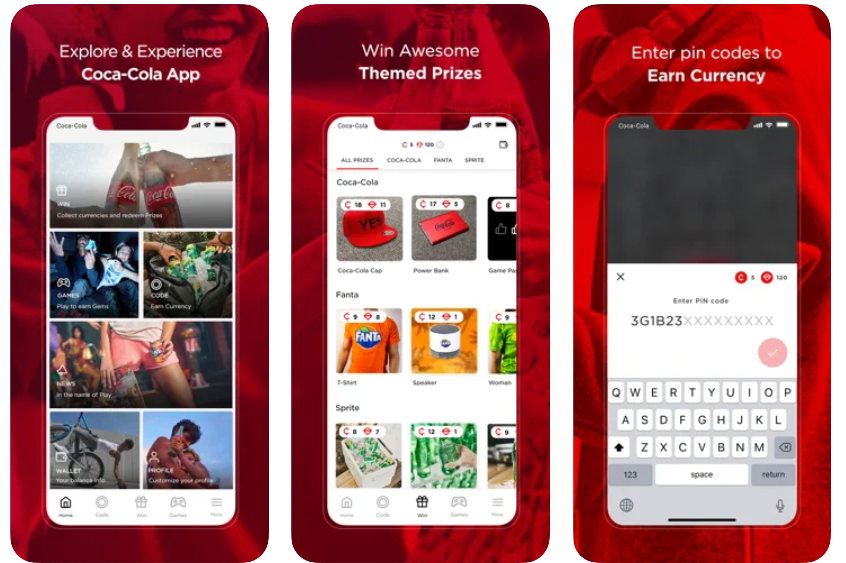
Another well-known brand that has decided to create a mobile application for their business is Coca-Cola. Using modern technologies such as artificial intelligence and machine learning, Coca-Cola analyzes data to understand consumer behavior based on purchasing patterns and how consumers respond to offers and campaigns.
In 2018, Coca-Cola embarked on a digital transformation to understand and meet their customers’ needs. The launch of the mobile app was part of their campaign for digital transformation. Now customers can redeem loyalty points and receive discounts on drinks. Additionally, in some countries, customers can use the loyalty app to purchase Coca-Cola brand soft drinks from vending machines.
Coca-Cola has managed to grow and generate higher margins than before the pandemic. To be more specific, the company’s revenue in the second quarter of 2021 exceeded its 2019 level of $10.13 billion, versus an expected $9.32 billion.
5. Starbucks

Launched in 2009, the Starbucks app initially allowed users to find nearby Starbucks shops and learn about coffee varieties. It also suggested drinks. Two years later, Starbucks increased its digital presence by rolling out its loyalty program to users’ smartphones with the Card Mobile app.
The Starbucks app now offers a wide range of services and features to customers. They can use the app to pre-order for pickup or scan and pay at a store. A loyalty system is also part of the mobile application: customers earn stars (rewards) that they can exchange for free food or drinks. Plus, the app offers useful features like the ability to choose a barista and see what song is playing at your local store.
With an innovative and streamlined mobile strategy, Starbucks has already brought in $621 million in mobile assets in 2013. In 2014, Starbucks earned $146 million, or 8% of total revenue, on an interest basis. In addition, operating costs have been significantly reduced by eliminating the need to outsource third-party credit card companies.
6. The Gap

It’s frustrating when you want to buy something but it’s out of stock at the store you go to. Gap has two features in its application to prevent customers from experiencing this. First, shoppers can check the availability of a product at their local store in the Gap app. What’s more, the app informs Gap staff when it’s time to restock a product or size on the sales floor.
The pandemic has made BOPIS (Buy Online, Pick Up In Store) something that consumers expect. While most e-commerce websites will support BOPIS, so can your mobile application. This means having a Gap-style inventory checker and letting users pick up an item that’s in stock at a nearby store. Some stores like Best Buy even let customers send text messages when they’re on the go.
7. L’Oréal
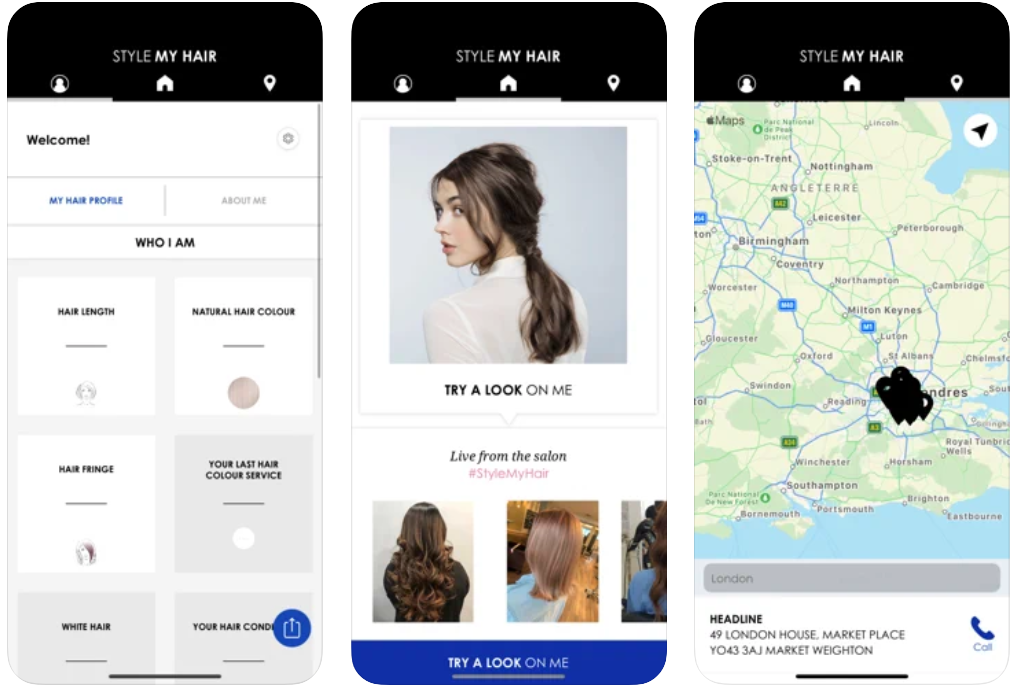
The L’Oréal app allows customers to try out a new shade before starting the process, without even leaving the store. The augmented reality app overlays any L’Oréal color on a live image on a user’s mobile phone. A customer can just pick an item in the store and scan the box.
The L’Oréal hair color modeling app takes the hassle out of coloring hair. Users can try on makeup the same way. Once they find the perfect shade, they can purchase it in a store or add it to a list for future delivery.
Augmented reality is the perfect technology to enhance real-life experiences. Your app can use AR in many different ways. Try organizing a trip to your store with a virtual scavenger hunt (similar to Pokémon Go). Or let shoppers scan boxes and interact with virtual products, reducing opened packages.
8. Nordstrom
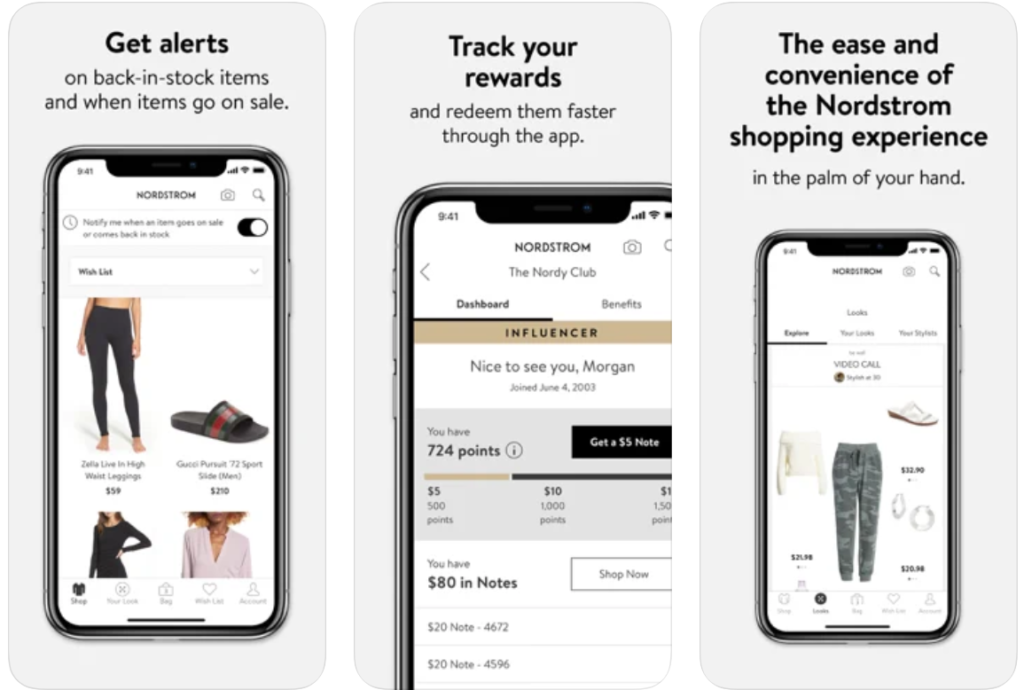
Through its app, Nordstrom has set up a locker room concierge service to reduce the stress of trying on clothes.
Using the Nordstrom app, a customer orders clothes to try on in the store. An employee then collects the pieces and places them in a dedicated fitting room, texting the shopper when they’re ready. The Nordstrom app offers shoppers in select markets to “come and taste” the latest fashion, with the option to order matching clothing and a dedicated fitting room.
According to a press release from Nordstrom, the first trials of the fitting room booking service were well received; 80% of customers who tried it came back to use it several times. Even if you don’t sell clothes, you can take a page from Nordstrom’s book. For example, you might allow app users to schedule time with a dedicated partner to find out about valuable items. Or sign up for group lessons or store demos. You can offer same-day discounts to boost conversions.
9. Pilot Flying J
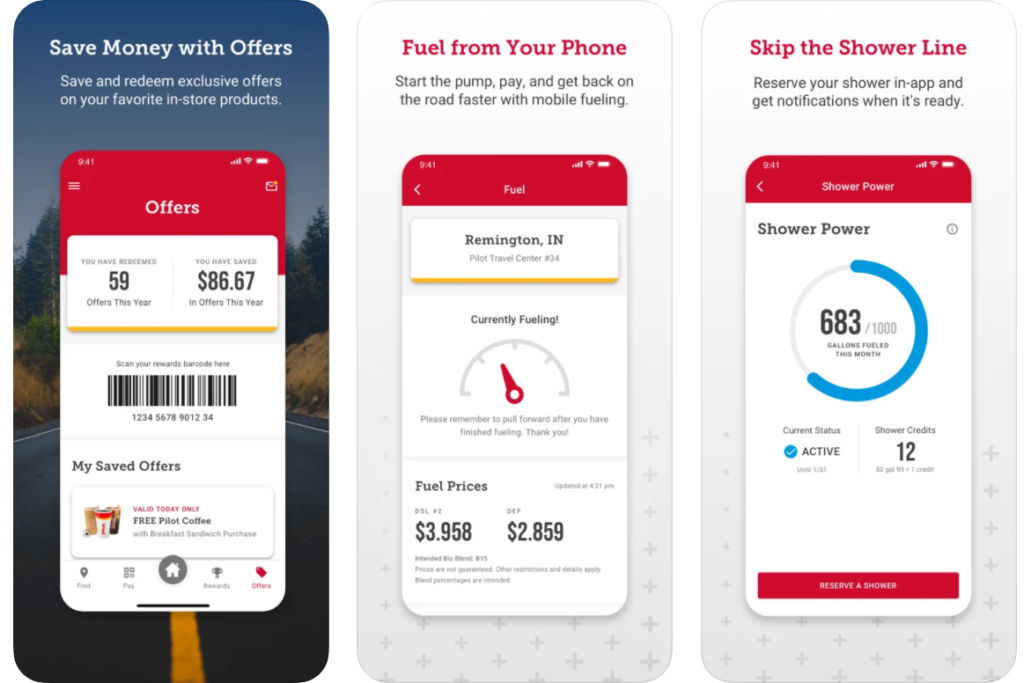
The Pareto Principle assumes that 80% of your sales come from 20% of your customers. Whether or not those percentages are accurate for your company, the point is that loyal customers are critical to growth. Pilot Flying J uses its app to surprise loyal customers with timely bonus offers.
App users who opt for location services and push notifications receive personalized product discounts based on previous behavior. These deals give loyal customers unexpected surprises and can help boost the average purchase price.
Discounts are a powerful motivator, but they’re not the only way to please repeat customers. Try to remind customers to buy frequently bought consumables like lip balm. And let them know when a new flavor of their favorite drink hits the shelf.
10. Macy’s
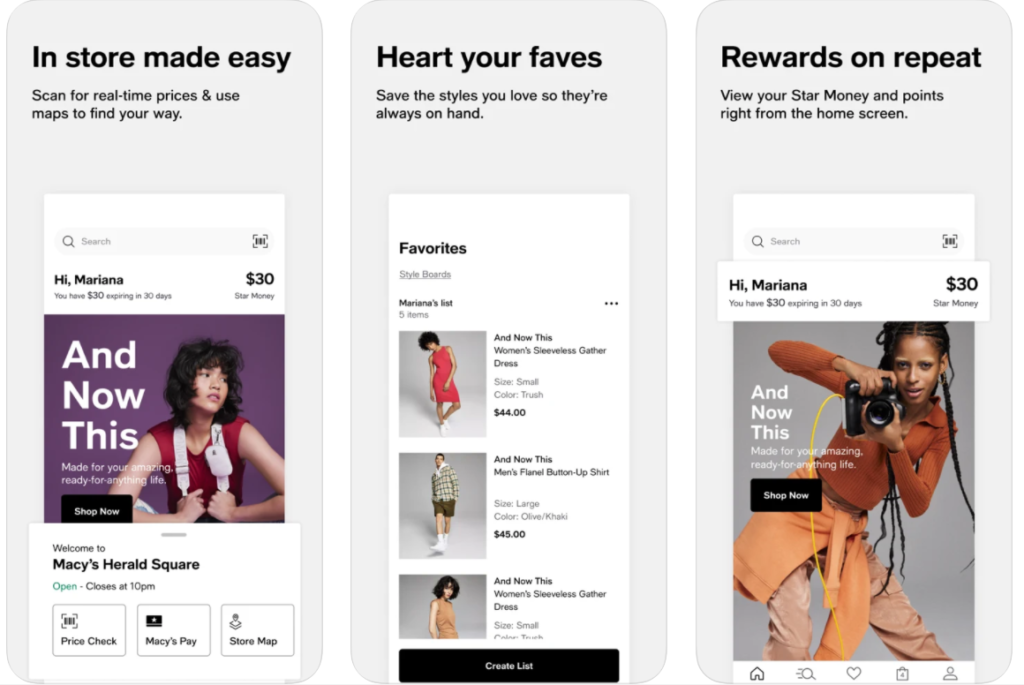
The retail giant Macy’s has one of the best download incentives of all retailers: 25% off your first app order! Now that they’ve grabbed your attention, Macy’s offers a few more useful features in its application. They give you the ability to scan an item in a store and pay on the spot without a queue.
The Macy’s app also allows you to take a photo of the item you want to buy and lets you know if it’s in stock or if the store has a similar item. Finally, the app includes a Pinterest-inspired feature that lets you create style boards and share them with friends.
5 retail app trends to boost mobile sales

1. Flexible app onboarding
Most commercial app developers struggle to get new users to learn about key features, share their data, and create accounts. Challenges with linear onboarding flows have prompted some retailers to try a different approach: instead of forcing new users to go through a step-by-step funnel, they embed traditional prompts into relevant areas of the app.
Allowing users to skip the traditional onboarding process means they can assess the value of the app on their own terms. In addition, they will learn why sharing personal data will improve their experience where it has the most context.
The Adidas First User Experience is a great example of how users can freely explore an app as well as how to encourage users to share their data so the app can be tailored to their preferences.
The first time users open the Adidas app, they see a splash screen with an optional three-screen tutorial. After that, users can immediately view products in the application. However, the home screen intelligently encourages users to share their location, shopping preferences, and birthday by embedding data queries between products and other content. When users share their interests, they get personalized recommendations.
By showing users the value they get from being enabled before the app asks for access, the likelihood of an increase in subscriptions is higher than with traditional pop-ups.
2. Personalized shopping experience across channels and devices
According to a Google study, 85% of online shoppers start shopping on one device and finish shopping on another. That’s why visionary brands are re-engaging shoppers by offering personalized content across devices and channels. They do this by sending relevant messages, offers, and content to customers based on their online browsing, mobile app activity, and store purchases.
Sephora provides cross-channel personalization to its members through its Beauty Insider program, which tracks user activity online, in mobile apps, and in-store. This information is then used to send customized product recommendations and change what a user sees when browsing the Sephora website.
3. Combine in-store shopping and mobile shopping to help shoppers make decisions
Mobile apps are increasingly being developed to complement and enhance the in-store shopping experience in order to drive in-store and digital sales. For example, many shopping apps now include additional product information such as pairing suggestions, customer reviews, and videos to make it easier for users to find products in the store and increase the likelihood of a purchase.
The Walmart mobile app includes a barcode scanner so shoppers can check prices and find product information in Walmart stores. However, customers can also use the app to order online from home. For example, users of the app can scan an empty tube of their favorite hand cream to order it online for home delivery or store pickup.
The app also provides users with local deals flyers to convince customers to come to nearby stores or check out weekly specials if they’re already in the store.
4. Increase the number of mobile conversions with convenient payment
The mobile cart abandonment rate is an alarming 85.65%. Determining the reason for shopping cart abandonment can be tricky. Everything from lengthy checkout procedures to lack of user feedback, guest checkout options, or security features can lead to users leaving.
Improving and simplifying the mobile verification process with incremental A/B testing is often the best way to identify areas for improvement.
Experimenting with the number of checkout steps, required margins, and copy or visuals are often useful starting points.
The checkout in the Best Buy mobile app is a great example of a simple checkout scheme. The app gives users the option to check out as a guest (which can reduce friction) and shows a progress bar to reduce impatience. It also doesn’t distract the customer.
Additionally, Best Buy offers the option to contact support for checkout assistance. Pop-ups offering live chat or phone assistance are becoming more popular in retail apps, so consider posting support information to help users complete their purchases.
5. Re-engage customers with creative custom push notifications
Push notifications continue to be one of the most effective ways to re-engage mobile users. However, it’s essential that push notifications stand out from the competition and do not annoy users. To overcome these hurdles, brands send out creative push notifications in a timely manner. These notifications use emojis, images (including GIFs), and funny texts to attract customers.
Retailers also use hyper-targeted messages to grab users’ attention. Push campaigns based on past purchases, featured categories, and more can help keep customers engaged. With the right segmentation capabilities, you can also customize push triggers based on things like location, number of days since last login, and other user behavior.
Final thoughts
Today’s businesses cannot afford the luxury of underestimating their mobile strategy. For your business, an app can keep your customers connected to your brand, help your business stay organized, and more importantly, help your business become more recognizable.
If you want to create a retail app but don’t know where to start, contact Mobindustry for a free consultation.


